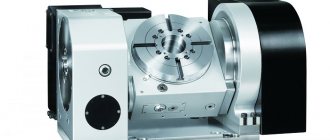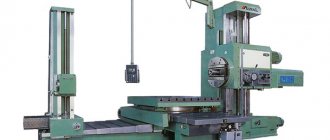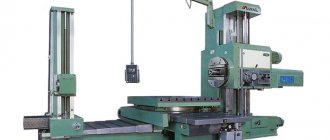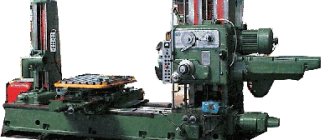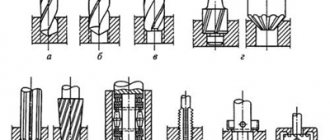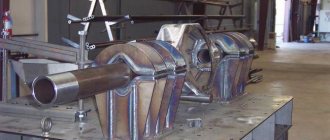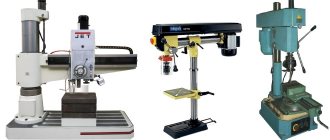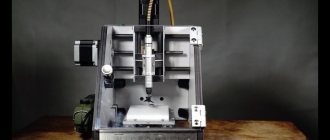The basic configuration of any equipment includes a set of mandatory functions, but often this is not enough to perform some operations. Additional equipment expands the possibilities. One type of such device is a rotary table for a milling machine. It is fixed to the base of the main structure and allows you to process complex shaped parts. Depending on the purpose, the size and brand of the rotary table is selected. It is important to consider equipment compatibility. Although in most cases such problems do not arise, since industry standards are as unified as possible and make it easy to use third-party products.
Rotary table device
Regardless of the class and complexity of the product, the principle of operation is the same for all. The basic elements of the device include:
- Base. Analogous to a machine bed. A system of attachment to the machine is required.
- Faceplate. Rotating part of the device. There is a hole in the center of the part (straight, but more often a Morse taper). There are T-shaped grooves on the working plane for fixing the workpiece or clamping mechanism. Modern models may use an original part fastening system. After installing the workpiece, the faceplate must be securely fixed in the desired position.
- Control. The faceplate can rotate around the central axis using a mechanical handle or an electric motor. CNC machines and specially designed rotary tables in modern design are programmable.
Milling machine table
The rigidity of the equipment itself depends on this part, and this is important during the milling process. The basic function of the rotary table of a CNC milling machine is convenient attachment of equipment for further processing of parts.
Rotary table for CNC milling work
The most important indicator of a device is its area; the ability to install parts of various sizes depends on it. The larger the working area of the rotary table for a milling machine, the greater its versatility.
In other words, if the product is small in size, it is very easy to fix it on a large surface. But a large part cannot be installed on a small rotating mechanism. The multifunctional installation solves such problems in a matter of seconds. To fully work with a modern unit, you need to carefully study the instructions, as well as try out different parts in operation.
Another positive quality of a large device is the ability to cut blanks. As a result, the manufacturability of milling equipment increases. There is no need to install special additional systems for these purposes.
The movable device of the unit must have a protective coating made of different materials, for example, plastic.
The design of such a mechanism must have high strength and be very rigid. Thus, the vibration that occurs during milling is dampened.
Operating principle of the equipment
The main task of the rotary table is to process parts in ways that are impossible on a conventional milling or lathe. The device allows you to realize the advantages of the above equipment. Parts in the form of a body of revolution are made on a lathe. It is impossible to leave unprocessed a part of the workpiece that extends beyond the cutting perimeter, but there is such a need. On a milling machine, a stationary part is processed using coordinate vectors. By installing a rotary table, you can make unfinished rotation bodies and bore holes that cannot be installed in a lathe.
The video shows how an automatic rotary table works for a 5-axis CNC machine.
This result is achieved by the fact that the workpiece is fixed not on the frame of the milling machine, but in a device that allows the workpiece to have an axis of rotation. This became the basic principle of operation of the turntable. Programmable equipment allows you to produce complex-shaped parts not on expensive machining centers, but using a regular milling machine, but with this wonderful device.
Comparing DETRON and analogues
One of the most frequently asked questions from technologists and production mechanics: how are Detron tables better and different from their analogues? To answer this question, we have prepared a table with the main characteristics of rotary tables from different companies. For convenience, the models are compared by table diameter.
Comparative table of DETRON technical characteristics with analogues from other manufacturers
| Specifications | units change | DETRON | other | DETRON | other | DETRON | other |
| Table diameter | mm | Ø210 | Ø255 | Ø320 | |||
| Center height | mm | 160 | 160 | 190 | 160 | 210 | 210 |
| Center hole diameter | mm | 40 | 45 | 140 | 40 | 180 | 40 |
| Bearing type | — | RB 10020 larger bearing, increased rigidity | RB 9016 | built-in spindle with built-in radial-axial bearing. Increased rigidity | tapered roller bearing | built-in spindle with built-in radial-axial bearing. Increased rigidity | tapered roller bearing |
| Dynamic load | kN | 33,1 | 31,4 | 156,8 | 108 | 196 (+31%) | 150 |
| Torque | kN・m | 2 (+19%) | 1.7 | 11 (+89%) | 5,8 | 17,5 (+50%) | 11,7 |
| Motor Worm Gear Module | mm | M2 (+14%) | M1.75 | M3 (+20%) | M2.5 | M3 | M3 |
| Clamping force | kg・m | 40 (+150%) | 16 | 90 (+80%) | 50 | 160 (+88%) | 85 |
| Brake design | — | — | — | Exclusive double ring drum brake. Safe seal | disc brake or single ring brake drum | Exclusive double ring drum brake. Safe seal | disc brake or single ring brake drum |
| Waterproofing | — | O-ring, IP65 | with silicone grease | O-ring, IP65 | with silicone grease | O-ring, IP65 | with silicone grease |
| Cutting torque tolerance | kg・m | 26 (+73%) | 15 | 55 (+15%) | 48 | 78 | 78 |
See the comparison of Detron tables with a diameter of 125 mm with analogues at the link
Comparison table of DETRON main components with analogues from other manufacturers
| Detron | TJR | G.S.A. | Atlas | |
| Spindle unit | Thickened spindle design Wide bearings Minimum number of composite nodes | Narrow bearings Thin spindle wall Large number of components | Thickened spindle design Wide bearings Minimum number of composite nodes | Large number of components |
| Worm shaft | Enlarged tooth by 30% | No information | Enlarged tooth by 30% | No information |
| Brake | Double piston | Single piston | Single piston | Brake hydraulic unit built into the table body |
| Adapter sleeve | An adapter sleeve is installed between the worm shaft sleeve and the needle bearing | No information | No information | No information |
For more information about the features and advantages of the Detron table design, see the link
| Rotary table GTFE-410HB | Indexing rotary table HH-500HT | Horizontal rotary table GH-630HT | Horizontal rotary table GH-500HT |
Equipment classification
It is customary to divide rotary tables according to several parameters. Firstly, in terms of working position. The equipment can be horizontal, vertical and universal, that is, it can work in two planes.
Secondly, in terms of size. The size of the faceplate is taken into account. It can vary from ∅ 110 mm to ∅ 630 mm. Tables of other sizes are possible, but these are special products made to order or for specific operations.
Thirdly, according to the method of adjustment and configuration. The equipment can be equipped with a simple mechanical handle, driven by the main machine and equipped with its own electric motor.
And finally, fourthly, a rotary table with expanded functionality. For example, it may have not one axis of rotation, but two, vertical and horizontal.
Certified models
The presence of a certificate indicates that the product meets all standards and safety requirements. Only after checking the list of characteristics, a quality certificate is issued. Such models include the following.
PROMA OS-250 250001
Used for milling, drilling, threading.
Characteristics:
- installed vertically and horizontally;
- rotation angle 360⁰;
- T-slots 6 pcs.
Installed on small milling machines for the production of single parts and small batches.
Homge HUT-300 universal
Tilt angle 90 degrees. Installation of the workpiece is simplified due to the presence of 2 locking bolts.
TSK 200 tilting rotary table
Used for circular milling, boring, creating corners and complex configurations.
Characteristics:
- rotary table with an inclination of up to 45⁰;
- mechanical control;
- high processing accuracy.
In addition to these devices, Vertex, Encore Corvette, Purelogic R&D products and many others are certified.
Performance characteristics
The variety of models from different manufacturers opens up wide possibilities for choosing a specific product to achieve clearly defined goals. The specifics of the enterprise determine the characteristics of the installed rotary table. For exclusive high-precision work, models from proven companies of the highest accuracy class are chosen. The tolerances for such equipment are minimal and are:
- Rotation angle - 1 sec;
- Straightness of the working surface - 3.0 microns;
- Faceplate end runout - 1.5 microns;
However, such rotary tables are not cheap and in practice there is no need to use them in normal production. Most devices in this category are offered at more affordable prices, but with quite acceptable characteristics:
- Rotation angle - 1 min;
- Straightness of the working surface - 10-20 microns;
- Faceplate end runout - 12-20 microns;
The central hole, as a rule, is made in the form of a Morse cone No. 3 or No. 4. A universal way to effectively center the workpiece. Morse tapers are used in a similar way in almost all metalworking machines.
Step-by-step instructions for making a wooden table
You will need plywood 18 mm thick, the sheet size is standard, you can buy a board of approximately 1.5 × 1.5 m. The table frame is made of 30 × 40 mm wooden blocks. The structure is fixed using ordinary wood screws. The tools you need to prepare are an electric jigsaw or a portable circular saw, a hand router, a drill or a screwdriver.
Standard milling table device
Making a countertop
Step 1. Cut a blank for the tabletop from a sheet of plywood. The size can be arbitrary, but not less than 80x80 cm. It is inconvenient to work on very small ones, the workpieces constantly fall, they have to be supported from the opposite side. Mark the plywood, attach it to the workbench with clamps, install a saw fence and carefully cut off the excess material.
Cut the sheet to the size of the tabletop
Practical advice. We strongly recommend that all work with an electric jigsaw and portable saw be done only under a ruler. You should not hope that you will get an even cut without this device.
Step 2. Mark the location of the hole for the cutter. This is also an arbitrary parameter. Much depends on whether you will subsequently adapt the stop ruler for the router, whether a box is provided for collecting and removing sawdust, what parts are supposed to be processed, etc. As practice shows, it is recommended to place the hole at a distance of 1/3 of the width from the longitudinal edge .
Mark the hole for the cutter
Make a mark and drill a hole. Its diameter should be only a few millimeters larger than the diameter of the largest cutter that will be used on this machine. There is no need to make a hole that is too large for several reasons:
- The larger the gap between the working knives of the cutter and the tabletop, the higher the likelihood that material will get into it. And this provokes the emergence of dangerous situations: the router may jam or fragments flying off at high speed may injure the craftsman;
- If you have to mill thin parts, the ends will vibrate strongly in the cracks - there is no stop. As a result, it is necessary to cut off uneven parts, which increases the consumption of lumber.
The hole is drilled with a special crown of the appropriate diameter.
Drill a hole according to the markings
Step 3. Place the router in the hole, making sure it is positioned correctly. Very carefully draw a line around the perimeter of the base. Make sure that the tool does not move during this process; always hold it with one hand.
Try the router on the hole and carefully trace it with a pencil
Step 4. Set the cutting depth on the router to 5 mm and very carefully cut out the seat along the drawn contour. Check the hole, insert the router into it. It should fit tightly and not wobble. If necessary, adjust the mounting socket to the required parameters. Everything is fine - excellent, remove the burrs with sandpaper and continue working on making the table for the router.
The seat must exactly match the contour of the router
Step 5. Prepare the same mounting nest on another piece of plywood, only now you need to make it through. Cut the part; its dimensions should be approximately 15–20 cm larger than the diameter of the router base.
Make a blank with a cutout of the same shape and size
Step 6. Place the workpiece on the countertop, align the holes and place the router in them. You need to note the location and dimensions of the two parallel guides. A router ruler is installed on them; in our case, it is removed. But you don’t need to touch the guides; they increase the reliability of fixing the router to the table and completely eliminate the possibility of rotating the body. The fact is that over time, the mounting socket may increase slightly in diameter, and the housing with the engine will begin to wobble. The long guides create fairly large arms that handle turning loads well.
The workpieces are combined and the router is inserted
Step 7. Measure the diameter of the metal pins, set the appropriate depth of the cutter and make grooves for them.
Cutting grooves for pins
Step 8. Connect the two table elements, put the router in place. Check the position carefully, turn the rotor manually, it should not touch anything. Everything is fine - screw the plywood.
After adjusting the elements, screw the blanks with self-tapping screws
Important. Be sure to screw the screws into the pre-drilled holes, otherwise cracks may appear. The diameter of the drill for the hole should be several millimeters smaller than the diameter of the threaded part of the hardware.
Manufacturing and insertion of the mounting plate
Screw the self-tapping screws around the perimeter of the stand at a distance of approximately 15 cm, secure the sections between the metal pins separately. Sand the surfaces again. This should not be done to improve the appearance, since the elements are located under the table and are invisible. By grinding, the surfaces are leveled, small chips are removed, the parts to be joined fit tightly, and the fixation is more reliable. And this is very important for any machine - vibration appears during operation, weak connections quickly become loose with all the negative consequences.
The entire surface must be sanded thoroughly
Step 9. Use small strips of plywood to secure the router in the working position. Turn on the power and check the operation of the tool. It should not wobble; if there are uncharacteristic noises, it is necessary to find their cause and be sure to eliminate it.
To fix the router, use two plywood strips
Everything is normal - proceed to the next step. Now we need to make a table frame for the tabletop.
Manufacturing of fasteners
Assembling the table frame
Step 1. Nail 30x40 mm slats to the bottom of the tabletop around the perimeter to add strength. Saw off the blanks at an angle of 45°, screw the parts with self-tapping screws of the appropriate length. Do not forget to lubricate the parts with wood glue before screwing. It performs two functions: it glues surfaces and perfectly aligns the cut planes, ensuring maximum stability of the connection.
Wooden blocks are attached along the perimeter of the tabletop
Step 2. Assemble the lower table support frame, it can have the same dimensions as the upper one.
Roll the frame from the bars to the size of the tabletop
Step 3. Attach the legs to it, the height is about 1 m, but adjust the specific values to suit your height, in which position it is most convenient to work, this should be the height of the table for the router. Be sure to install corner braces, otherwise the structure will become loose over time.
The legs are attached to the frame, after which the frame is reinforced with spacers
Step 4. Check the strength of the structure, try to tilt it, bend it, etc. with great effort. If you find any wobbling, install additional spacers and levers, the number depends on the actual need. You don’t need to pay special attention to the appearance; you are not making beautiful furniture for the living room, but a durable machine for the workshop. The difference in requirements is significant. The frame is ready, install the tabletop in place and you can start working.
Putting the tabletop in place
What kind of work is a rotary table used for?
The scope of application in metalworking is extremely wide.
Manufacturing of complex parts, such as flanges with fasteners, elements of mechanism housings. Effectively machining holes in parts that cannot be properly oriented in the lathe chuck. Workpieces with certain angular distances. Milling of grooves, ledges. Drilling holes at the same distance from the center of the part with a precisely specified angle relative to each other. It is very reasonable to use tooling for small- and medium-scale production. CNC machines and programmable rotary tables do much the same work as jig boring machines and machining centers.
Limitations in processing can only be caused by the size of the workpiece. The departure relative to the fixation point is regulated by the norms and rules of operation. The larger the part, the larger the diameter of the turntable faceplate should be. Exceeding the recommended values is unacceptable.
Tools that expand the capabilities of metalworking equipment
The milling machine work table moves linearly in 2 or 3 directions. The rotary table rotates the workpiece, turning it towards the spindle with the cutting tool, different faces and tilting it at an angle. This allows you to perform several operations from one installation, and more accurately maintain center-to-center dimensions and the distance from protrusions and grooves.
Sinus
The sine table is highly accurate. Rotates with an accuracy of one second. Helical gears and spiral grooves are installed due to the synchronous rotation of the faceplate and its tilt at an angle. For manual control there is coarse and fine adjustment, 2 dials for each movement.
For drilling machine
Overhead rotary tables are installed on the drilling machine table with a radial arrangement of holes. Uniform rotation of the part allows the drill to make holes at an equal distance from the center of rotation, eliminating constant rearrangements. A table with an inclination of up to 45 degrees is designed for drilling at an angle to the surface of the part.
Round, magnetic
Magnetic electric coils are excited when current is applied to them, several times faster than conventional mechanical fastening. The part lying on the working surface is instantly attracted or released. The machine operator does not have to turn the screws or wait for them to be mechanically tightened. This prevents overtightening of the bolts.
The advantages of a magnetic table are the quick fixation of parts without dents or deformations. The disadvantage of installing in a limited number of materials is that only carbon and alloy steels are magnetized.
Reference! Non-ferrous alloys, stainless steel, aluminum and copper cannot be fixed on a magnetic table.
Installing equipment on the machine
There should be no difficulties when fixing it to the base plate of the milling machine. The freely movable mounting bolts in the T-slots are brought into the mating holes or slots and the nuts are tightened. The operation is simple, but the considerable weight of the device requires caution during transportation. Place the turntable on a surface completely cleared of debris. The fit must be complete. The next stage of work will be setting up the equipment. The operation requires knowledge, experience and qualifications.
There are several ways to position the turntable correctly. Simple work where there is no need to maintain micron accuracy allows adjustment without special tools. A touch is made on a test workpiece with a cutter, then the table is rotated 180° and the operation of the cutting tool is repeated at a similar value. Tolerances and deviations are measured and adjusted by the required amount. It is much more difficult to configure equipment for high-precision work. Only qualified craftsmen can do it efficiently using special tools. Stops and limit switches are installed. A test sample is tested and if the accuracy requirements are met, then work begins. The technical specifications indicate the number of required measurements. All critical details are checked. When releasing a batch of products, you can measure not each one, but through the recommended number of pieces.
Homemade tilt-rotary machine for metal and wood machines
In a home workshop where there is a milling machine, it is good to have a rotary table among the devices. They are sold in stores if you need to make a lot of parts. Hobbyists can make the device themselves.
Required tools and materials
The easiest way to make a device yourself is from a lathe chuck. To do this you will need the following tools:
- screwdriver;
- Bulgarian;
- hex and socket wrenches;
- welding machine.
The rotary table consists of parts:
- scroll chuck;
- base with 2 ears;
- limb from the drawing board;
- clamps;
- bolts;
- 2 disks.
Ears with holes for bolts are welded to the base for fastening to the working surface of the machine. The limb is installed between 2 washers above the base. An inspection window is cut out in the body of the cartridge to see the divisions. The part is clamped into the jaws and rotated manually.
Drawings and calculations: When making a device yourself from scrap materials, a calculation is made of the stroke of the worm shaft and the number of teeth on the disk through its radius. Then a tap with the required pitch for cutting the disk is selected.
Step-by-step instruction
The disk is fixed on the workbench and put on the axle. Fasteners are installed. A screw is screwed in near the edge, against which the tap inserted into the electric drill rests. On its side it rests against the surface of the disk. When rotated, it cuts the tooth. The worm is installed in the housing in engagement with the cut teeth on the disk. A dial with a handle is attached to its end. Everything is attached to the base.
Safety precautions
When making a device, it is necessary to check the condition of the tool and the wires of the electric drill and welding machine, the grounding of the equipment and sockets. Even in a home workshop, you should wear overalls with long sleeves and safety glasses. The workplace must be cleared of unnecessary objects and well lit.
A rotary table for a milling machine increases the functionality of the equipment and allows you to make more complex parts with less time. For home use, you can make the device yourself.
Advantages and disadvantages
Unsatisfactory performance of the equipment may be due to the wrong choice of model, or insufficient qualifications of the employee. The characteristics are clearly stated in the accompanying documents and, as a rule, guaranteed by the manufacturer. Individual cases of manufacturing defects are resolved on an individual basis.
The turntable has plenty of advantages. Having such equipment in your arsenal, you can master additional types of work or launch the production of new products. Some operations can be optimized. One of the applications of the rotary table is the processing of complex welded structures. They are often processed by hand. It takes a lot of time, and the quality leaves much to be desired. By setting up a milling machine with a rotary table for such an operation, the geometric dimensions of the parts become an order of magnitude more accurate, and the processing time is reduced many times over.
The payback of equipment depends on production volumes and can vary within significant limits, but there is no doubt that the enterprise will benefit in the quality of manufactured products.
Rotating table cost
Despite the wide variety of models and offers, the cost of rotary tables varies greatly. As mentioned above, the main purpose of the rotary table is to install and fix parts for processing on milling equipment. The device consists of several separate parts:
- housings;
- worm wheel and worm;
- faceplates;
Currently, the range of such equipment is so extensive that even an inexperienced specialist can choose the ideal solution for specific conditions. It is enough to take into account the indicators of the price segment and technical characteristics. All products come with separate quality certificates, and the exact cost can be found directly from the seller. In any case, buying such a product is not an indicator of luxury, so every modern person can afford it.
